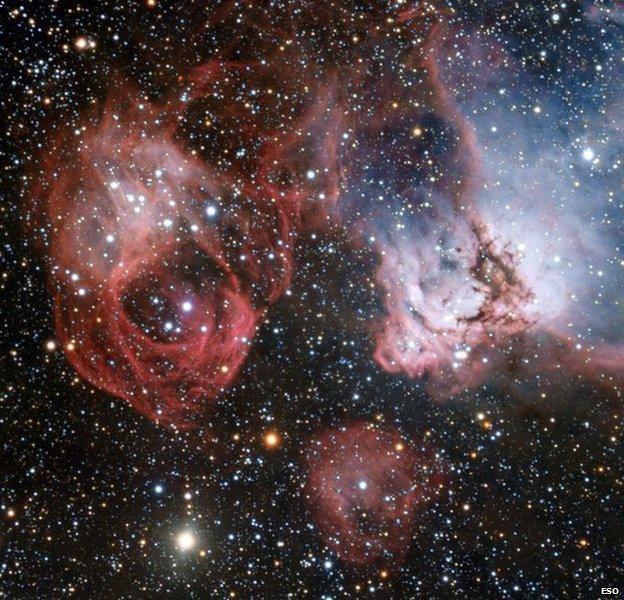Birth and death of stars captured by Very Large Telescope
- Published

"Watching little pieces of the Universe next door"
A new image has captured the birth and death of stars in one of our closest galactic neighbours - the Large Magellanic Cloud.
It also shows the remnants a supernova explosion caused by the death of a massive star that has run out of fuel.
Located about 163,000 light-years away, the LMC is visible with the naked eye from the Southern Hemisphere.
The detailed image was taken by the European Southern Observatory's Very Large Telescope in Chile.
Its nebulae - the thick clouds of gas around young and old stars - house active star-forming regions.
Their brilliant glow is caused by the intense heat generated when new young stars are born, stars that burn very brightly but live relatively short lives when compared with our own Sun.
Due to its unique shape, the cluster on right of the image has been nicknamed the Dragon's Head Nebula, though its official name is the catchy NGC 2035 (new general catalogue).
Olivier Hainaut, an astronomer who worked at the Chile observatory for many years, said that a lot of imagination was needed to see a dragon's head.
"Most of these names were given when the telescopes were not as good as they are today, so you have to imagine a blurry thumbnail version of it," he explained.
And the vibrant colours of the nebulae give clues to how hot the young stars are inside them.
A star formation region with remnants of a supernova explosion has been captured
The blue stars are huge, hot stars that live a short but very bright life, while the redder ones are much colder.
As a star ionises surrounding gas, it kicks the electrons out of atoms which then radiate light in signature spectral lines.
The darker lines that are visible are clusters of dust mixed in with the gas - their darker colour results from light absorption rather than light emission.
Once massive stars burn their fuel, they become increasingly unstable until they collapse and violently explode as supernovas, remnants of which are visible on the left of the image.
The Large Magellanic Cloud (LMC) is a small satellite galaxy - smaller than the Milky Way, or the nearby Andromeda Galaxy, which can also be seen with the naked eye.
While it spans 14,000 light-years, the LMC contains less than one tenth of the mass of the Milky Way, which covers some 100,000 light-years.
It was named after Ferdinand Magellan, a Portuguese-born navigator, who noticed the nebulae on his voyage to the Southern Hemisphere.
Dr Hainaut said that pictures like this were very beautiful, like art.
"The next step is that you realise we are watching little pieces of the Universe next door. Just to see all these stars that are being born - it's a really nice story to see that our Universe is moving and evolving," he told BBC News.
- Published8 August 2013
- Published8 March 2013
- Published4 August 2010